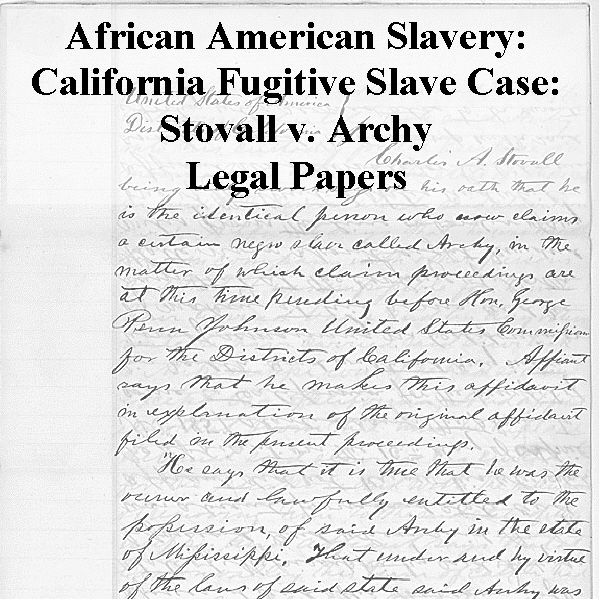
African American Slavery: California Fugitive Slave Case: Stovall v. Archy Legal Papers
$19.50
Description
The Stovall v. Archy Case: A Timeline of Freedom
- 1840: Archy Lee is born into slavery in Mississippi.
- October 2, 1857: Charles Stovall, Archy Lee’s slave owner, brings Lee with him to Sacramento, California. While in California, Stovall opens a private school and rents out Archy Lee.
- January 1858: Charles Stovall decides to return to Mississippi. Archy Lee, then 18, escapes from Stovall while en route to a ship departing California and returns to Sacramento.
- January 26, 1858: Sacramento County Court (Judge Robert Robinson) rules that Archy Lee is a free man. The court reasons that California is a free state and, crucially, Stovall’s length of residence in California indicates he has become a permanent resident, thus unable to own slaves. The Fugitive Slave Law of 1850 is deemed not to apply.
- Late January/Early February 1858 (Approximate): Archy Lee is re-arrested following the county court ruling.
- February 11, 1858: The California Supreme Court rules on the case. It overturns the lower court’s decision, asserting that the Fugitive Slave Law does apply when slaveowners are only temporary sojourners in the state (as Stovall claimed to be). The court makes an exception for Stovall due to his “inexperience and poor health,” allowing him to leave California with Archy Lee as his property.
- March/April 1858 (Approximate): Free blacks in San Francisco intervene to prevent Stovall from sending Archy Lee back to Mississippi by sea. They take out writs charging kidnapping, which are served by the San Francisco police.
- March/April 1858 (Approximate): The case rapidly moves from San Francisco County Court to the San Francisco jurisdiction of the U.S. Commissioner. Stovall expects the Commissioner, being a Southerner, to rule in his favor.
- April 14, 1858: The U.S. Commissioner concludes that Archy Lee is not a fugitive slave and orders his release. This ruling is based on evidence suggesting Stovall was not merely a temporary sojourner, contrary to his initial claims.
- 1861: An excerpt from “The Fugitive Slave Law and its Victims,” an anti-slavery tract published by the American Anti-Slavery Society, covers the Stovall case, highlighting its significance in the abolitionist movement.
- 1893: Newspaper articles continue to cover the Stovall v. Archy case, indicating its lasting impact and public interest.
- 1999: The National Park Service publishes “Civil Rights, Racial Protest, And Anti-Slavery Activism in San Francisco, 1850-1865” by Albert S. Broussard, which includes significant content on the Stovall case.
- 2012: The National Park Service publishes “Sweet Freedom’s Plains: African Americans on the Overland Trails 1841-1869,” a study that provides information about Archy Lee, the Stovall case, and California’s Fugitive Slave Act of 1852.
Cast of Characters:
- Archy Lee: An African American man, born into slavery in Mississippi in 1840. He was brought to California by his owner, Charles Stovall, and later escaped. His legal battles for freedom in California became a landmark federal fugitive slave case, involving multiple levels of the judiciary and the activism of free black communities.
- Charles Stovall: Archy Lee’s slave owner, who brought Lee from Mississippi to California in 1857. He attempted to reclaim Lee as his property after Lee escaped, initiating the series of legal proceedings known as Stovall v. Archy. His claim of being a “temporary sojourner” in California was central to the legal arguments.
- Judge Robert Robinson: The judge in the Sacramento County Court who initially ruled that Archy Lee was a free man, based on Stovall’s extended residence in California.
- Charles Parker: An active member of the free black community in Sacramento. He filed a petition for a writ of habeas corpus on Archy Lee’s behalf, playing a crucial role in the initial legal efforts to secure Archy’s freedom.
- U.S. Commissioner (San Francisco Jurisdiction): The federal official who ultimately concluded on April 14, 1858, that Archy Lee was not a fugitive slave and ordered his release. Despite Stovall’s expectation of a favorable ruling due to the Commissioner being a Southerner, the evidence presented led to Archy’s freedom.
- S. J. Noble: An individual who provided an affidavit in the Stovall v. Archy case, presumably supporting Stovall’s account.
- E. H. Baker: An individual who provided an affidavit in the Stovall v. Archy case, presumably supporting Stovall’s account.
- E. R. Doyle: An individual who provided an affidavit in the Stovall v. Archy case, presumably supporting Stovall’s account.
- Free Blacks of Sacramento and San Francisco: A crucial collective group, though not individually named in all instances, who actively aided Archy Lee. They helped him hide after his initial escape, initiated legal actions (like Charles Parker’s habeas corpus petition), and took out writs charging kidnapping to prevent his forced return to Mississippi, demonstrating significant anti-slavery activism and community solidarity.
African American Slavery: California Fugitive Slave Case: Stovall v. Archy Legal Papers
Including additional material this collection has a total of 409 pages.
Stovall v. Archy is the only known federal fugitive slave case tried in California, a “free state.” Archy Lee was an African American born into slavery in Mississippi in 1840. Lee’s slave-owner was Charles Stovall, he brought Lee with him to Sacramento, California on October 2, 1857. While in California, Stovall opened a private school and rented out Lee. In January 1858, when Stovall decided to return to Mississippi, Lee, then age 18, escaped from Stovall while on the way to a ship heading out of California and returned to Sacramento.
On January 26, 1858, Judge Robert Robinson ruled that Lee was a free man because California was a free state and, though Mississippi was a slave state, Stovall had become a permanent resident of California, and thus could not own slaves. The California Supreme Court on February 11, 1858, ruled that although California prohibited slave ownership for state residents, Stovall’s inexperience and poor health warranted an exception and that he be allowed to leave the state with Lee as his property. The case then went to the federal judiciary.
This collection includes:
Court Documents – California Fugitive Slave Case: Stovall v. Archy
32 pages of court filings from the case Stovall v. Archy (1858). Legal papers filed with the U.S. Commissioner, U.S. Circuit Court, Northern District of California (San Francisco).
Very little of the original federal case material remains on file at the National Archives-Pacific Region (San Francisco). The surviving documents in this case file were mostly filed by Stovall (the slaveowner). These give Stovall’s account of his and Archy’s travels from Mississippi to California, where Stovall hired Archy out as a laborer.
Included among the documents are the petition of C. A. Stovall; affidavits of C. A. Stovall, S. J. Noble; E. H. Baker, and E. R. Doyle; the warrant of arrest for Archie Lee; the subpoena for Archie’s witnesses; and unsigned, undated notes, believed to be those of the U.S. Commissioner on application of Fugitive Slave Act in the case.
With the aid of some free blacks, Archy attempted to hide from Stovall to avoid being sent back to Mississippi, leading to his arrest as a fugitive.
Charles Parker, an active member of the large free black community in Sacramento, then filed a petition for writ of habeas corpus. The case was first tried at the Sacramento County Court in 1858. Because of the length of Stovall’s residence in California, the county ruled that the Fugitive Slave Law of 1850 did not apply and that Archy was free.
Archy was re-arrested, however, and the case then moved to the California Supreme Court. That court ruled that the Fugitive Slave Law did apply when slaveowners were only temporary sojourners in the state (as Stovall claimed to be). Stovall then attempted to send Archy back to Mississippi by sea, but this attempt was checked by free blacks who took out writs charging kidnapping, which were served by the San Francisco police.
The case moved rapidly from San Francisco County Court to the San Francisco jurisdiction of the U.S. Commissioner, a southerner Stovall expected would find for the slaveowner. However, the Commissioner concluded on April 14, 1858, that Archy was not a fugitive slave and should be released. The “Brief for Respondent” and a few other filings suggest a version of events very different from Stovall’s initial claim that he was a temporary sojourner in California.
The Fugitive Slave Law and its Victims (1861) Excerpt
An excerpt from an anti-slavery tract published by the American Anti-Slavery Society in 1861 with material covering the Stovall case.
Newspaper Articles
34 pages of newspaper articles dating from 1858 to 1893 with coverage of Stovall v. Archy (1858). Most pages are from California newspapers published in March and April of 1858.
Civil Rights, Racial Protest, and Anti-Slavery Activism in San Francisco, 1850-1865 (1999)
The National Park Service in 1999 published the study, “Civil Rights, Racial Protest, And Anti-Slavery Activism in San Francisco, 1850-1865,” by Albert S. Broussard. It contains significant content concerning the Stovall Case and broad issues involved in the case.
Sweet Freedom’s Plains: African Americans on the Overland Trails 1841-1869 (2012)
This 271-page study, published by the National Park Service in 2012 contains information about Archy Lee, the Stovall Case, and California’s Fugitive Slave Act of 1852. This study examines African American participation in the great overland trails emigrations that occurred in the nineteenth century. It focuses on the history of African Americans on the California, Oregon and Mormon Trails from 1841 to 1869, when the transcontinental railroad was completed. The study explores three interrelated themes: black emigrants’ experiences on the overland trails, their perceptions of the journey, and their perceptions of the West and their new communities.
Related products
-
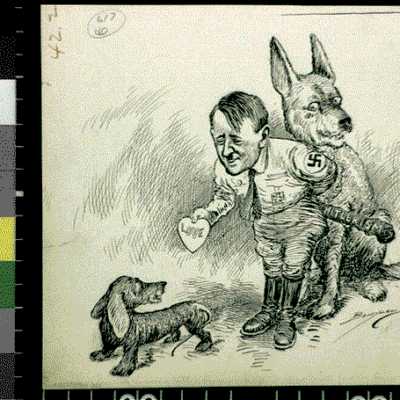
Clifford Berryman’s Political Cartoons from World War II
$19.50 Add to Cart -
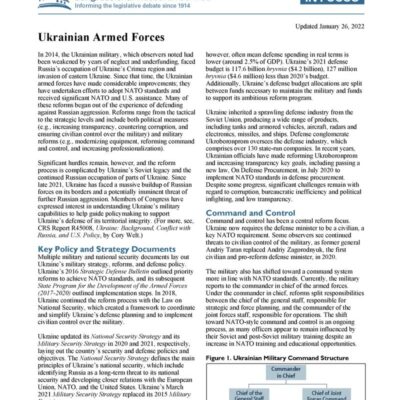

Ukraine – U.S. & Russia Relations: CRS Briefing Book 2004-2022
$3.94 Add to Cart -
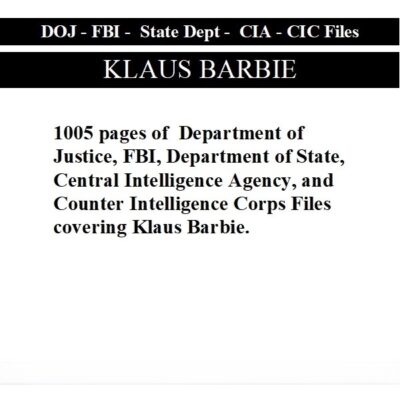
Klaus Barbie: Department of Justice – FBI – Counter Intelligence Corps Files
$19.50 Add to Cart -
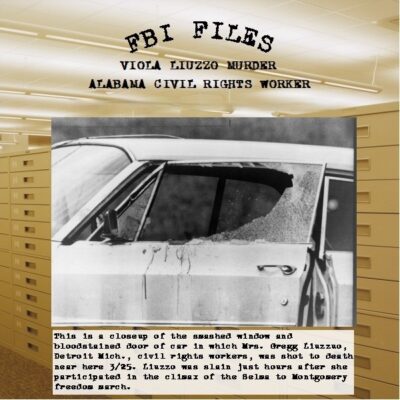
Viola Liuzzo Murder – Alabama KKK FBI Files – President Johnson Secret Phone Recordings
$19.50 Add to Cart